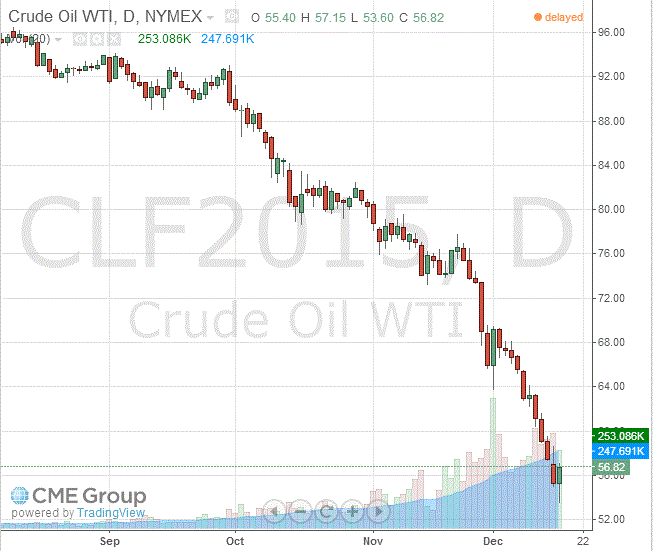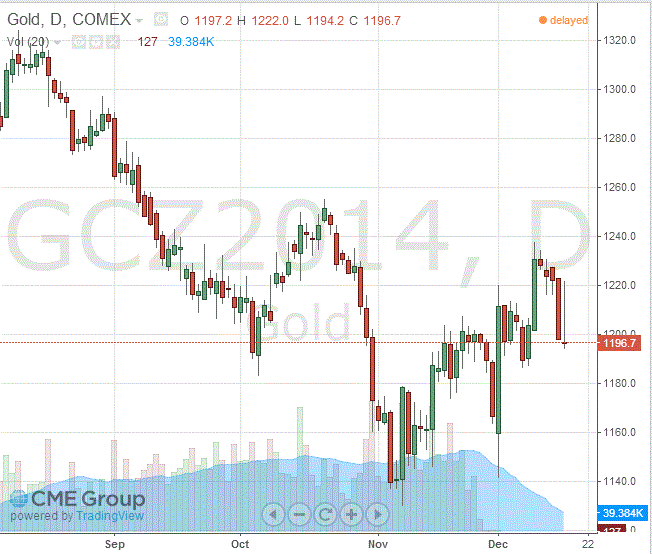Notícias do Mercado
-
16:40
Oil: a review of the market situation
The price of oil rose moderately after earlier today for the first time since 2009, close to $ 59 per barrel (mark Brent), which was associated with a decrease in activity in the manufacturing sector in China and the weakening of currencies of developing countries.
Previously presented data showed that business activity in the manufacturing industry in China in December fell to 7-month low. Preliminary index of purchasing managers (PMI) of China's processing industry, calculated by HSBC and Markit Economics, dropped to 49.5 points from 50 points in November. Analysts on average expected 49.8 points. Value below 50 indicates a contraction of manufacturing activity compared with the previous month, while the figure above 50 indicates growth. The data suggest the decline in the Chinese economy, despite the loose monetary policy of the Central Bank of the country.
Analysts say that the oil market is also affected by the deterioration of the economies of developing countries and the depreciation of their currencies. The Bank of Russia on Monday raised its key repo rate once a week by 6.5 percentage points to 17 per cent per annum, trying to stop a collapse of the ruble.
Meanwhile, experts Goldman Sachs today announced that future oil projects worth $ 930 billion is under threat because of falling prices for it to about $ 60 per barrel. Refusal of the development of these projects will decrease in production in the world in the next 10 years to 7.5 million barrels per day (b / d), which is about 8% of the current global demand for oil. According to experts, an overabundance of oil, which has caused a drop in prices, could soon disappear as major oil producers will postpone the launch expensive projects, which, in turn, affect the production of gasoline, fuel oil and chemicals.
Market participants also gradually transferred his attention to the meeting of the Federal Reserve System, which should begin later today and give clues on the timing of rate increases in the future.
Cost of January futures for US light crude oil WTI (Light Sweet Crude Oil) rose to 56.82 dollars per barrel on the New York Mercantile Exchange.
January futures price for North Sea petroleum mix of Brent increased by $ 0.10 to $ 60.47 a barrel on the London Stock Exchange ICE Futures Europe.
-
16:20
Gold: a review of the market situation
Gold prices fell sharply, losing the position of all previously earned and again fell below $ 1,200. Experts point out that gold could come under pressure in the conditions of market expectations the Fed's monetary policy. Talk about the fact that the central bank may abandon his former statement, which said that rates will remain near zero "for an extended period of time," on Wednesday, supported the US dollar and damaged precious metals in recent days. Gold, which does not bring interest income, can hardly compete with the assets generating interest income when interest rates rise.
"The market will be unstable if the central bank will not abandon the phrase" considerable time ", - said an analyst at Australia and New Zealand Banking Group Victor Tyanpiriya.
According to the analyst Edward Meir INTL FCStone, the Fed will leave in a statement the phrase "considerable time" to give yourself time to evaluate the impact of the slow growth of the world economy on the US economy. "If our estimates are correct, the dollar will weaken, and commodity markets rise, so we prefer to hold long positions on the eve of the statement" - wrote Meir in the report.
The course of trading also influenced today's data for Germany and the eurozone. Recall confidence in the German economy rose to its highest level since May 2014. The indicator of economic sentiment rose sharply by 23.4 points to 34.9 in December. It was the second consecutive growth and index reached its highest level since May 2014.
"This increase is due to favorable economic conditions, such as a weak euro and low price of oil," said ZEW President Prof. Clemens Fuest. Assessment of the current situation rose by 6.7 points to 10 points in December. It was expected that the evaluation will rise to 5. sentiment indicator in the euro area rose by 20.8 points to 31.8 points in December. At the same time, the indicator of the current situation declined by 3.1 points to minus 62.8 points.
Meanwhile, a report on the euro area showed that private sector growth accelerated more than expected, up to 2-month high in December. The composite output index increased to 51.7 in December, the highest value in two months, from 51.1 in November. Economists forecast that the PMI reached 51.5. In the service sector purchasing managers index rose to 51.9 from 51.1 a month ago. Evaluation, according to forecasts, should increase to 51.6. The result also noted 2-month high. Moreover, the manufacturing PMI rose to a 5-month high of 50.8 from 50.1 in November. Reading, is expected to grow to 50.5.
As for the situation in the physical markets, gold imports from India increased by 38 per cent in October, reaching 151.58 tons in November, according to data provided by the Ministry of Commerce.
The cost of the December gold futures on the COMEX today fell $ 10.5 to 1196.70 dollars per ounce.
-
11:25
Oil: Brent Crude below $60
Brent crude and West Texas Intermediate are trading at new lows. Brent Crude lost -2.88%, currently trading at USD59.30 a barrel. Crude slipped below the 60 dollar mark, its lowest since May 2009. West Texas Intermediate declined -2.56% currently quoted at USD54.48, a new five-year low. OPEC's decision taken on November 27th in Vienna to not cut output rates to fight for market shares weighs on prices. Crude almost lost 45% this year amid concerns about global economic growth and cooling demand. Yesterday United Arab Emirates energy minister said that the OPEC will not trim production while other producers continue to expand. Data on China's slowing Factory Output put further pressure on prices.
-
11:00
Gold prices recover after yesterday’s slide
Gold prices recover after yesterday's drop, the biggest one-day loss in 2014 sliding to USD1,190.30. The precious metal is currently quoted at USD1,198.00 or +0,36% a troy ounce. Market participants are awaiting the result of the FED's two-day meeting starting today to assess the timing of a benchmark interest rate hike. Experts specializing in the projections of US policy, note that the Fed could remove the phrase "extended period" and replace it with the phrase about the slow rate increase, depending on the incoming data. However, to not reach the target level of inflation in the United States could force the monetary authorities to remain faithful to the formulation of the long-term.
GOLD currently trading at USD1,198.00
-
09:20
Press Review: Ruble Fails to Sustain Gains After Surprise Russia Rate Increase
REUTERS
Gold edges up after worst day in a year, Fed eyed
SINGAPORE, Dec 16 (Reuters) - Gold edged higher on Tuesday, aided by a softer dollar, after falling more than 2 percent in the prior session in its deepest slide in over a year following a sustained slump in oil prices.
Apart from oil, investors are eyeing the Federal Reserve's two-day policy meeting which kicks off on Tuesday for clues on the timing of an increase in U.S. interest rates.
The U.S. economy has strengthened and jobs have been created at a faster-than-expected clip since the Fed's last meeting in October, when it reiterated that benchmark rates were unlikely to rise for a "considerable time".
Source: http://www.reuters.com/article/2014/12/16/markets-precious-idUSL3N0U016U20141216
BLOOMBERG
Ruble Fails to Sustain Gains After Surprise Russia Rate Increase
The ruble failed to sustain its biggest advance in 16 years in a sign slumping oil is outweighing Russia's attempt to defuse a currency crisis with the largest interest-rate increase since 1998.
The ruble erased a gain of as much as 10.8 percent, trading 0.3 percent lower at 64.6320 a dollar by 11:42 a.m. in Moscow, following a surprise Bank of Russia decision to take its key interest rate to 17 percent from 10.5 percent. Ten-year government bond yields jumped more than two percentage points to cross 15 percent for the first time.
BLOOMBERG
Why 1998 Was Different, and Same, to Emerging-Market Crisis Now
Oil prices were tanking. Emerging-market currencies were in a freefall. Venezuela was mired in a financial crisis and Russia had sunk into a debt default and devaluation.
The year was 1998.
Emerging markets today look a lot like they did back then. Yet there have been key changes that could help most of them escape full-blown crises. Here's a look at the similarities and differences between now and then.
-


